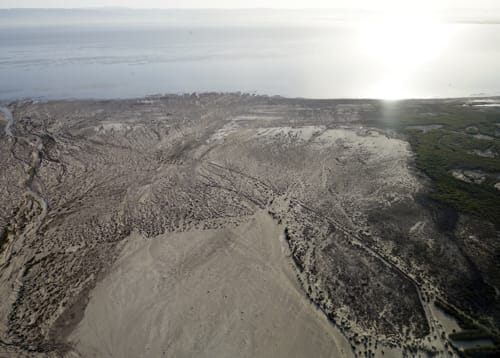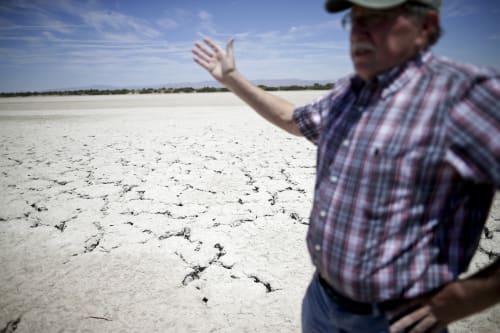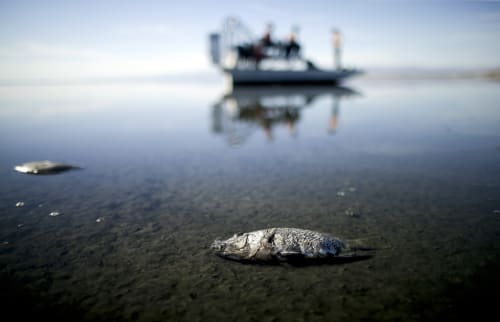ormer Southern Nevada Water Authority chief Pat Mulroy is backing an audacious idea she says could free up more Colorado River water and solve a mounting public health and environmental problem in the California desert.
For a few billion dollars, Mulroy said, a pipeline could be built through Mexico to deliver ocean water to California’s Salton Sea. Some of the water would be used to stabilize the shallow, shrinking, inland sump. Some of it would be pushed through a new desalination plant and used to irrigate Imperial Valley crops currently grown using river water.
She said the plan could free up as much as 1.5 million acre-feet of Colorado River water, some of which Nevada could use to augment its comparatively tiny 300,000-acre-foot annual share of the river.

The exposed, fried lakebed of the Salton Sea is seen in May 2015 near Niland, Calif. (The Associated Press File)
Best of all, the Salton Sea is home to enough geothermal energy resources to pump all that water and power the desalination plant, Mulroy said. “So you environmentally stabilize the Salton Sea, you solve the air quality problems for all those poor people in Palm Springs, and you create an alternate water source using non-carbon-emitting power that’s right there locally.”
As for the cost, Mulroy said the federal government can pay for the construction and the seven Western states that share the river can cover maintenance and operation of the system.
“Don’t tell me there aren’t possibilities out there,” she said. “There are, if you start thinking in a different context.”
‘Staggeringly expensive’
Colorado River expert John Fleck said he tries not to make a habit of disagreeing with Mulroy, but this idea seems like a serious overreach to him.
“It’s staggeringly expensive, and I think the people who are trying to sell it right now are hugely lowballing the costs,” the New Mexico-based author and academic said.
Current water authority chief John Entsminger also ranks among the skeptics.
“Anything’s possible with enough money,” he quipped. “I haven’t seen that being proposed as a realistic solution by the state of California or the Imperial Irrigation District. In my experience working in water, unless you hear the locals proposing it first, it’s not necessarily a project that’s going to get legs.”

Bruce Wilcox of the Imperial Irrigation District speaks during an interview in front of cracked, exposed Salton Sea lakebed near Niland, Calif., in April 2015. Between 2003 and 2015, the lake’s shrinkage had already exposed about 25 square miles of salt-encrusted lakebed. (Associated Press File)
They may not be openly campaigning for ocean pipelines and desalination plants, but Imperial Irrigation District officials are demanding action on the Salton Sea, which is already causing major air quality problems from blowing dust left behind by the shrinking shoreline.
As part of its recent approval of the interstate Drought Contingency Plan for the Colorado River, the powerful agricultural district demanded $200 million in federal matching funds to execute California’s 10-year plan to stabilize the sea.
“The decline of the Salton Sea presents serious public health and environmental crises,” said district spokesman Robert Schettler. “We have been concerned about the Salton Sea for a long time and have worked, and continue to do so, with our partners to bring attention to it.”
Importing ocean water to stablize the sea is not part of the California’s 10-year plan, but state officials are talking about it.
Bruce Wilcox, assistant secretary of Salton Sea policy for the California Natural Resources Agency, said there are a limited number of possible solutions to the problem, and “this is one of those.”
“It’s going to be expensive,” Wilcox said. “Almost anything we do at the Salton Sea is going to be expensive.”
A whale of a plan
This isn’t the first time Mulroy has recommended a massive infrastructure project to fix a regional water issue. It’s not even her most expensive proposal to date.
During her time as water authority chief, Mulroy made headlines for suggesting floodwater from the Mississippi River could be diverted west to recharge the massive Ogallala Aquifer beneath the central Plains and irrigate crops as far away as Colorado, New Mexico and Arizona, relieving some of the strain on the Colorado and its tributaries.

A man fishes for tilapia along the receding banks of the Salton Sea near Bombay Beach, Calif., in April 2015. (Associated Press File)
Such a diversion project would almost certainly take decades to complete and cost tens or even hundreds of billions of dollars.
That idea didn’t originate with Mulroy, and neither did the Salton Sea solution, which has been kicking around for the past decade or more. But both proposals represent what she sees as the only way forward for the Colorado: sweeping investment and collaboration.
“There is a structural deficit in this river. You have more water that’s been given out to use than the system has,” Mulroy said. “The sooner we start putting together a seven-state, two-country portfolio of augmentation projects … the better. (Otherwise) we’re going to be in trouble. We’re going to be in big trouble.”
Contact Henry Brean at hbrean@reviewjournal.com or 702-383-0350. Follow @RefriedBrean on Twitter.



